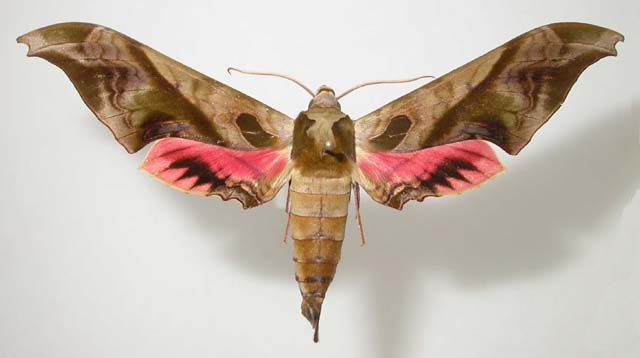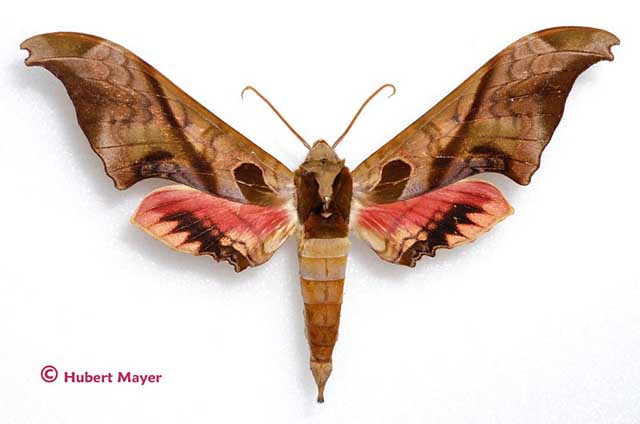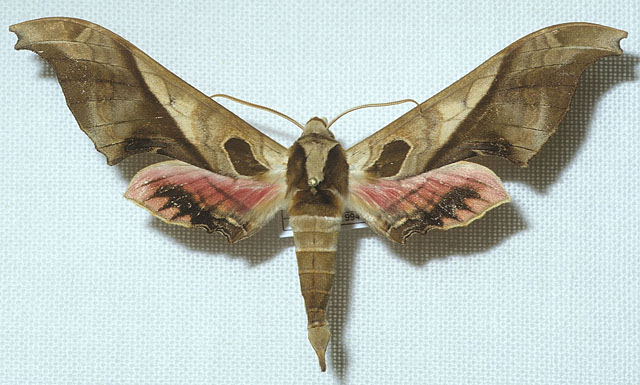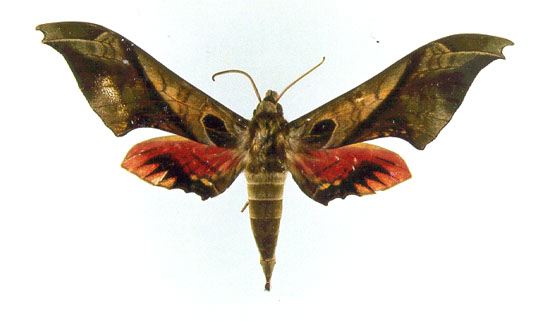Adhemarius mexicanus
|
|
Updated as per personal communication with Jean Haxaire
Updated as per personal communication with Manual Balcazar-Lara
Updated as per CATE Sphingidae (Jalapa, Veracruz, Mexico); August 8, 2011
Updated as per personal communication with Hubert Mayer (Patla, Puebla, Mexico; July); August 8, 2011
Updated as per personal comunication with Vladim Kroutov (Veracruz, Mexico, male and female; recto and verso images); June 16, 2014
|
Adhemarius mexicanus
ad-heh-MAHRR-ee-usMmex-ih-KAHN-us
Balcázar & Beutelspacher, 2001

Adhemarius mexicanus,
courtesy of Jean Haxaire

Adhemarius mexicanus HT male, Sierra de Juarez, La Esperanza, Santiago Comaltepec, Oaxaca, Mexico,
March 28, 1984, 1600m, Manual Balcazar-Lara.
This site has been created by Bill Oehlke.
Comments, suggestions and/or additional information are welcomed by Bill.
| TAXONOMY:
Superfamily: Sphingoidea, Dyar, 1902
Family: Sphingidae, Latreille, 1802
Subfamily: Sphinginae, Latreille, 1802
Tribe: Smerinthini, Grote & Robinson, 1865
Genus: Adhemarius, Oiticica, 1939
Species: mexicanus, Balcázar & Beutelspacher, 2001 |
DISTRIBUTION:
Adhemarius mexicanus flies in
Mexico: Oaxaca: Santiago Comaltepec.
It possibly also flies in Jalisco, Puebla: Patla, Guerrero, and maybe
Jalisco; to Puebla: Patla; Veracruz: Jalapa; and
Both males and females from the donysa group (donysa, antonkozlovi, blanchadorum, dariensis, globifer, mexicanus can be difficult to distinguish.
Males can often be determined by the following characters:
Adhemarius blanchardorum: Thus far only found in Texas. Forewing usually grey-green with narrower, dark, sub-apical patch that is indented distally
at M2 and M2 and sharply delimited basally.
Adhemarius dariensis has a forewing outer margin that is slightly convex. The apex is relatively broad, and gound colour is usually grey-brown with a
forewing length of 53mm or greater. In fresh specimens the forewing oter margin is slightly scalloped.
Adhemarius donysa has a relatively broad forewing with apex only slightly produced. The median line is only slightly oblique. The thick black hindwing
markings are subtrapezoidal and do not fully extend along the veins to the outer margin.
Adhemarius globifer has a relatively more extensive and internally rounded, large, dark, subapical patch on the forewing. Perhaps that is how it gots its name, globifer,
bearing or carrying a globe. Both the forewing and hindwing outer margins, near the anal angle, are deeply notched/dentate.
Adhemarius mexicanus has a relatively narrow, ellongated forewing with apex greatly produced. The median line is very prominent (thick) and quite oblique.
Hindwing underside median curves toward body as it nears the costa. Hw dorsal balck markings extend along veins to outer margin.

Adhemarius mexicanus male, Patla, Puebla, Mexico,
July 2003, courtesy of Hubert Mayer
The pronunciation of scientific names is troublesome for many. The "suggestion" at the top of the page is merely a suggestion. It is based on
commonly accepted English pronunciation of Greek names and/or some fairly well accepted "rules" for latinized scientific names.
The suggested pronunciations, on this page and on other pages, are primarily put forward to assist those who hear with internal ears as they read.
There are many collectors from different countries whose intonations and accents would be different.
Some of the early describers/namers chose genus and species names indicating some character of the insect, but more often, they simply chose
names from Greek or Roman mythology or history.Those species names which end in "ensis" indicate a specimen locale, and those which end in "i", pronounced "eye",
honour a contempory friend/collector/etc.
José Oiticica Filho (1906 - 1964), the French entomologist/photographer who assigned the genus name, Adhemarius, possibly chose the name
from Adhemarus, the fifth and last of the old counts of Querci (Verdun, France) who died in 880 AD.
The species name, mexicana, recognizes the specimen type locality, Mexico.

Adhemarius mexicanus, Mexico, courtesy of Hubert Mayer copyright.

Adhemarius mexicanus male, Veracruz, Mexico,
courtesy of Vadim Kroutov
FLIGHT TIMES AND PREFERRED FOOD PLANTS:
Adhemarius mexicanus probably produces at least two broods annually. Hubert Mayer reports a July
flight in Patla, Puebla, Mexico.
Adhemarius mexicanus larvae probably feed upon ??

Adhemarius mexicanus, Mexico, courtesy of Manuel Balcazar-Lara.

Adhemarius mexicanus female, Veracruz, Mexico,
courtesy of Vadim Kroutov
ECLOSION, SCENTING AND MATING:
Females are slightly larger than males.

Adhemarius mexicanus Pair, Veracruz, Mexico,
courtesy of Vadim Kroutov

Adhemarius mexicanus Pair (verso), Veracruz, Mexico,
courtesy of Vadim Kroutov
EGGS, LARVAE AND PUPAE:
Larval Food Plants
Listed below are primary food plant(s) and alternate food plants. It is hoped that this alphabetical listing followed by the common name of the foodplant
will prove useful. The list is not exhaustive. Experimenting with closely related foodplants is worthwhile.
Return to Smerinthini Tribe
Return to Main Sphingidae Index








